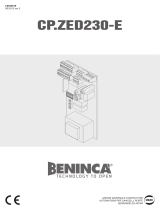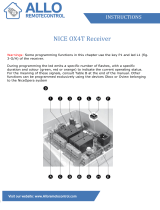12
Proceed as follows:
1 Press the hidden key of the already memorized transmitter, the courtesy light switches off.
2 Within 10 sec., press the key of the already memorized transmitter, the function of which is to be
copied. The courtesy light and the DL1 LED switch up.
3 Within 10 seconds, press the hidden key of the new transmitter, the function of which is to be matched.
The courtesy light and the DL 1 LED start flashing (1 flashing/sec).
4 Within 10 seconds, press the key of the transmitter to which the function, selected at point 2, is to be
matched. The courtesy light and the DL1 LED switch up for 1 sec.
5 The new transmitter is stored in memory, the receiver exits the programming mode.
Example: the P.P. function, which is to be matched to key 2 of the new “B” TX, is stored on key 1 of
“A” TX. Press in sequence:
hidden key of A TX >> key 1 of A TX >> hidden key of B TX >>key 2 of B TX
Cancelling all transmitters from the memory
- Keep the PGM key pressed for 15 sec, the DL1 LED and the courtesy light start flashing rapidly and
switch off at completion of cancellation.
- Release the PGM key and the memory is now erased.
N.B.:
For safety reasons, transmitters cannot be memorised during the open/close cycles of the motor.
When entering the memorise transmitter procedure, if the Power LED gives a prolonged blink and then
goes out, this signals that the receiver memory is full and no other transmitters can be memorised or that
the transmitter is not compatible.
Storage in memory of the opening and closing positions
After carrying out the electric connections of the control unit and the safety, control and indication devices,
the door opening and closing positions must be memorized.
First of all place the opening and closing mechanical stoppers in the correct position:
- manually release the door and completely close it. Place the closing mechanical stopper in the closed
position on the driving carrier and fix it.
- completely open the door. Place the opening mechanical stopper in the open position on the driving
carrier and fix it.
For further information, please refer to the Manual for use supplied with the operator.
Now the opening and closing positions can be stored in memory:
- with door stopped, press keys PGM+CL for about 5 seconds until the LED DL1 switches on
- the control unit is now ready to store the closing position in memory
- press and keep the CL key pressed until the carrier reaches the CLOSING mechanical stopper. Release
the CL key and press the PGM key for 1 second. The LED switches on and off and the position is therefore
stored in the control unit memory.
- press and keep the PP key pressed until the carrier reaches the OPENING mechanical stopper. Release
the PP key and press the PGM key for 1 second. The LED switches off and the position is therefore stored
in the control unit memory.
Tensioning of the belt
Once the closing mechanical stopper is reached, a brief opening reversion command is given to avert that
the belt remains tensioned.
This reversion movement can be adjusted (or excluded), if required, as follows:
- Press the PGM key once for 1 sec, the courtesy light and the DL1 LED starts flashing with 1sec intervals.
- Press the PGM key again and keep it pressed until the courtesy light and the DL1 LED switch on.
- Release the PGM key and the DL1 LED starts flashing (from 1 to 4 flashes), followed by an interval.
- The number of flashes can be modified by pressing the P.P. key, select the value amongst the following:
1 FLASH with interval: disabled reversion
2 FLASHES with interval: minimum reversion
3 FLASHES with interval: medium reversion (default presetting)
4 FLASHES with interval: maximum reversion
- Confirm the selection by pressing the PGM key, or wait for 10 seconds.
Carry out some trial operations to check the correct operation of the system.






















